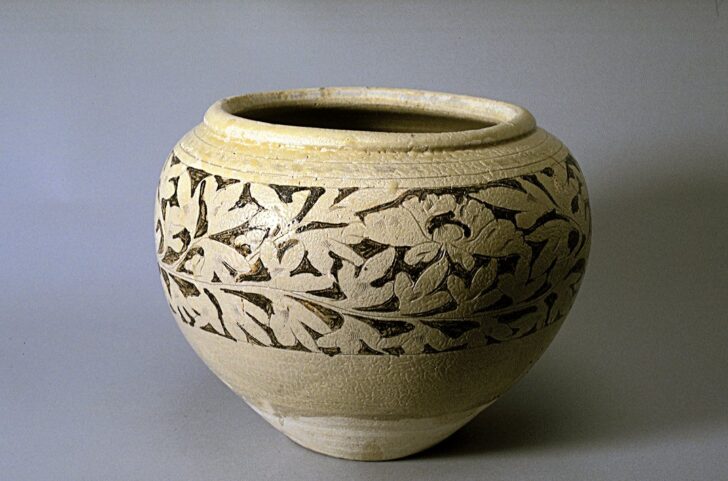Jar
Chinese

Description
While the Japanese favor the cherry blossom, in China the peony is perhaps the most beloved flower. Its deep-colored and many-petaled blooms suggest an almost intoxicating self-indulgence; the flower is associated with the imperial court, with wealth, and with erotic beauty.
Maribeth Graybill, Senior Curator of Asian Art
Exhibited in "Flora and Fauna in Chinese Art," April 6, 2002 - December 1, 2002.
Sgraffiato was a method of decorating pottery in which a surface layer of slip (liquid clay) was scraped or carved away to create a pattern and expose a ground— the clay body or a deeper layer of slip (as is the case here) —of a contrasting color. The vessel was then coated with a colorless glaze and fired. This mode of ceramic decoration developed as an affordable alternative to luxury parcel-gilt silver vessels. The peony flower’s multi-foliate leaf makes a fine foil for the lush, heavy blooms as they scroll across the body of a vessel as seen in this jar.
(Label for UMMA Chinese Gallery Opening Rotation, March 2009)
Subject Matter:
A cizhou (磁州) ware jar of the Liao dynasty (916-1125) with sgraffito decoration of a band of peonies around the body. While the Japanese favor the cherry blossom, in China the peony is perhaps the most beloved flower. Its deep-colored and many-petaled blooms suggest an almost intoxicating self-indulgence; the flower is associated with the imperial court, with wealth, and with erotic beauty.
Sgraffito was a method of decorating pottery in which a surface layer of slip was scraped or carved away to create a pattern and expose a ground— the recessed clay body—paInted in the recesses with a contrasting, dark color. The vessel was then coated with a colorless glaze and fired. This mode of ceramic decoration developed as an affordable alternative to luxury parcel-gilt silver vessels. The peony flower’s multi-foliate leaf makes a fine foil for the lush, heavy blooms as they scroll across the body of a vessel as seen in this jar.
Cizhou ware has been well known since the Song dynasty with production lasting through the Qing, but it reached its zenith during the Jin and Yuan dynasties, where the forms were especially robust and decoration finely executed. The ware is characterized by its high contrast dark brown to black and white wares, although over a dozen types of decoration can be used. These techniques include painting, sgraffito, incision, overglaze, underglaze, along with the application of multi-colored glazes. The variety of sub-styles is a result from being produced at a variety of Northern kilns in Hebei, Henan, Shandong, and Shanxi. These everyday, if not somewhat plebeian wares consisted primarily of large jars, vases, pillows, and bowls.
Physical Description:
A stoneware globular jar with wide mouth and belly tapering towards the foot. The jar is covered in a white slip, carved with floral meander, and painted in the recesses with a dark under glaze. It is covered in a translucent glaze.
Usage Rights:
If you are interested in using an image for a publication, please visit https://umma.umich.edu/request-image/ for more information and to fill out the online Image Rights and Reproductions Request Form.